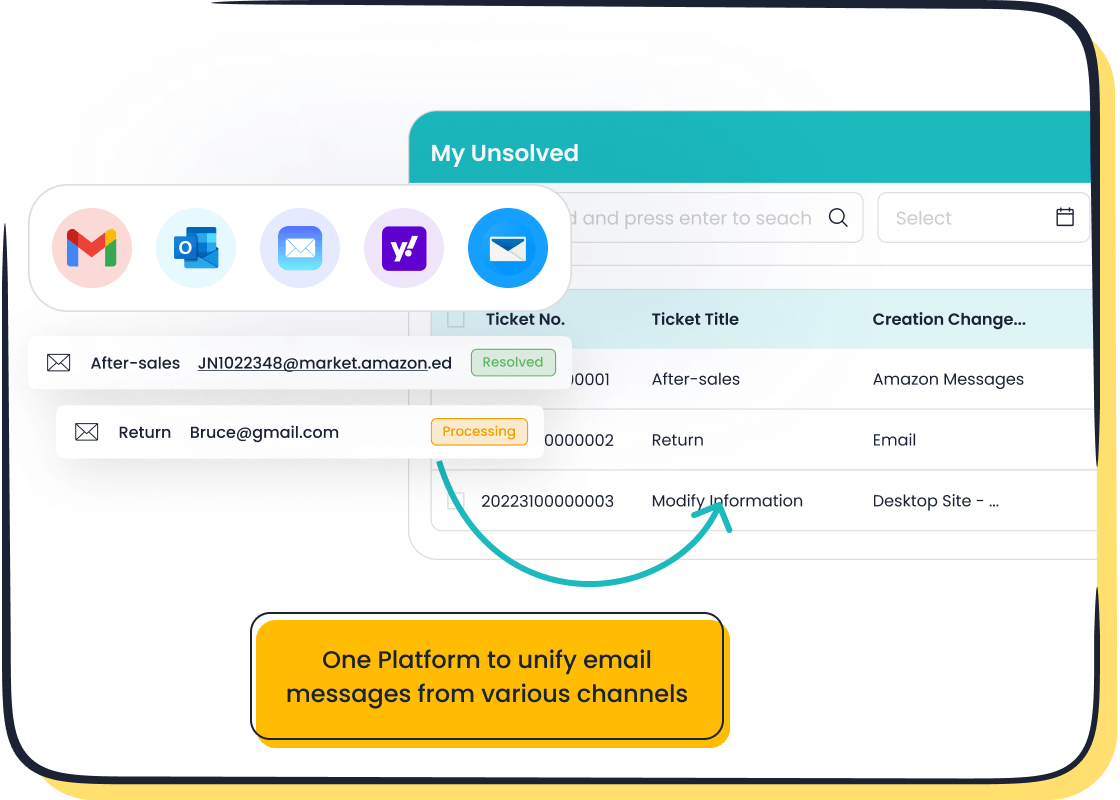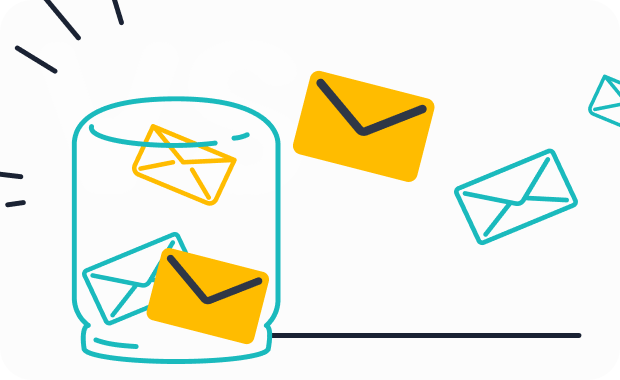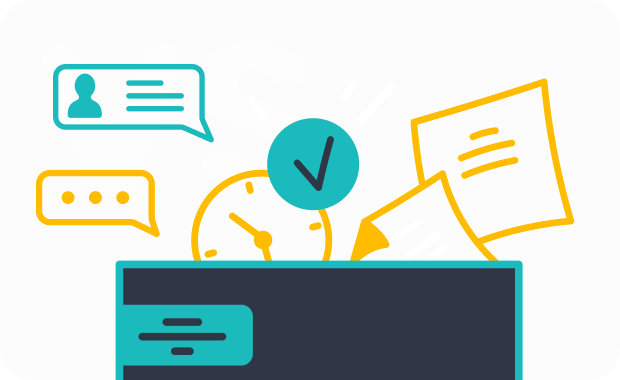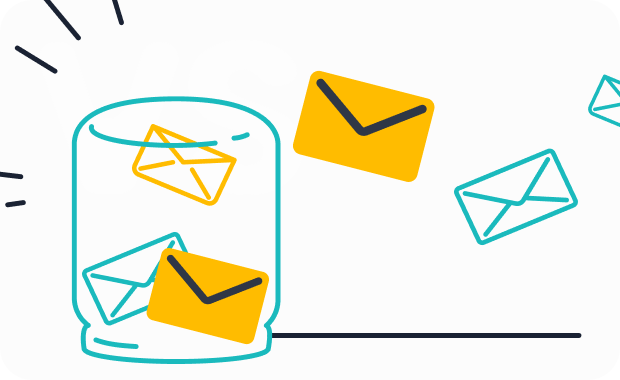How to Streamline Support with Customer Service Email Software

Efficient customer service keeps your customers happy and your business thriving. Managing emails manually often leads to missed inquiries and slower responses. That’s where customer service email software steps in. Tools like Sobot’s Ticketing System simplify email management, automate workflows, and boost team productivity. For example, Sobot’s platform has helped businesses resolve 85% of customer issues while achieving a 97% CSAT score. It also enables 22.2% of inquiries to be handled independently, reducing workloads and improving satisfaction. With Sobot, you can transform your support operations into a seamless, customer-focused experience.
Identifying the Need for Customer Service Email Software
Recognizing Challenges in Current Customer Support
Common issues in email-based customer service
Managing customer service through email alone can feel like juggling too many balls at once. You might notice delays in responses, missed inquiries, or even duplicate efforts from your team. These issues often stem from a lack of organization and tracking tools. For example, without a proper system, it’s hard to prioritize emails or ensure they’re routed to the right person.
Here’s a quick look at some common challenges organizations face:
| Metric | Description |
|---|---|
| Response Time | Long delays in replying to customer inquiries. |
| Resolution Time | Extended periods to resolve issues, frustrating customers. |
| Email Volume | Overwhelming numbers of emails, making it hard to keep up. |
| Abandoned Emails | Unanswered emails that leave customers dissatisfied. |
| Customer Satisfaction (CSAT) | Low scores due to inconsistent or delayed responses. |
If these sound familiar, it’s a sign your team could benefit from customer service email software.
Indicators your organization needs email management software
How do you know it’s time to upgrade? Look for these red flags:
- Your team struggles to keep up with growing email volumes.
- Customers complain about slow responses or unresolved issues.
- You notice duplicate efforts or confusion among team members.
- Important emails slip through the cracks, leading to missed opportunities.
If any of these resonate, it’s time to consider a solution like Sobot’s Ticketing System. It centralizes email management, automates workflows, and ensures no inquiry goes unanswered.
Benefits of Customer Service Email Software
Enhanced organization and tracking of customer inquiries

Customer service email software brings order to chaos. It organizes all your emails in one place, making it easy to track inquiries and their status. Tools like Sobot’s Ticketing System even allow you to prioritize tickets based on urgency. With features like automated ticket routing and SLA reminders, you’ll never lose track of an email again.
Improved team collaboration and response times
When your team works together seamlessly, customers notice. Customer service email software prevents duplicate work by assigning tickets to the right agents. It also enables real-time collaboration, so your team can resolve issues faster. For instance, Sobot’s platform integrates with CRMs and other tools, ensuring everyone has the information they need to respond quickly and accurately.
Pro Tip: Faster response times and better collaboration lead to higher customer satisfaction and loyalty.
Choosing the Right Customer Service Email Software

Defining Key Requirements
Essential features of customer service email management software
When selecting customer service email software, focus on features that simplify your operations. Look for tools that centralize email management, automate ticket routing, and provide SLA tracking. A unified inbox is essential for managing inquiries from multiple channels. Features like canned responses and priority classification save time and ensure consistency. Sobot’s Ticketing System, for example, offers multilingual support and integrates seamlessly with email, voicemail, and chat, making it a versatile choice for businesses of all sizes.
Scalability and integration with existing systems
Your customer service software should grow with your business. Scalability ensures the system can handle increasing email volumes and additional users as your team expands. Integration capabilities are equally important. Tools like Sobot’s Ticketing System connect with CRMs and e-commerce platforms, ensuring smooth workflows and better data accessibility. This compatibility reduces manual effort and enhances overall efficiency.
Evaluating Software Options
Comparing popular tools, including Sobot's Ticketing System
Choosing the right software involves comparing options. Here’s a quick overview of popular tools:
| Software | Description | Pricing (per agent/month) | Pros | Cons |
|---|---|---|---|---|
| Sobot Ticketing System | Unified platform with AI-powered ticketing and SLA management. | Custom Pricing | Multilingual support, seamless integration, automation features. | N/A |
| Freshdesk | Highly customizable, AI-driven software suitable for all business sizes. | Free to $79 | Comprehensive AI features, high customizability, user-friendly. | Best features missing from cheaper plans. |
| Help Scout | User-friendly software with a shared inbox for collaboration. | N/A | Easy to use, great for team collaboration. | N/A |
Sobot stands out with its intelligent automation and ability to unify communication channels. Its custom trigger rules and analytics tools make it a powerful solution for improving customer service.
Assessing user reviews and case studies
User reviews and case studies provide valuable insights. For instance, OPPO, a global leader in smart devices, implemented Sobot’s Ticketing System to streamline customer service. The result? An 83% chatbot resolution rate and a 94% positive feedback score. Real-world examples like this highlight the system’s effectiveness in improving response times and customer satisfaction.
Testing Before Implementation
Importance of trials and demos
Testing customer service email software before full implementation is crucial. Trials and demos help you identify usability issues and ensure the software meets your needs. They also allow you to evaluate performance and refine workflows. For example, Sobot offers demos to showcase its Ticketing System’s capabilities, helping you make an informed decision.
Key factors to evaluate during testing
During testing, focus on these factors:
- Ease of use: Is the interface intuitive for your team?
- Performance: Does the software handle your email volume efficiently?
- Integration: Can it connect with your existing tools?
- Automation: Are workflows streamlined and customizable?
Testing ensures you choose a solution that aligns with your goals and enhances your customer service operations.
Preparing for Implementation
Planning the Implementation Process
Setting clear objectives and timelines
A successful implementation starts with clear goals and a realistic timeline. Begin by identifying what you want to achieve with the new customer service email software. Are you aiming to reduce response times, improve team collaboration, or enhance customer satisfaction? Once you’ve set your objectives, break the process into manageable steps.
Here’s a roadmap to guide your planning:
- Functional leads submit technical requirements to the technical team.
- Collaborate with the vendor to customize the software for your organization’s needs.
- Conduct pilot tests to evaluate the software’s capabilities.
- Perform user acceptance testing to ensure everything runs smoothly.
- Assign roles for transitioning from the old system to the new one.
- Officially launch the software and monitor its performance.
This structured approach ensures a smooth rollout and minimizes disruptions to your operations.
Assigning roles and responsibilities
Assigning clear roles is essential for a seamless transition. Designate a project manager to oversee the implementation and act as the main point of contact. Technical teams should handle software integration, while customer service leaders focus on training and adoption. By defining responsibilities upfront, you’ll avoid confusion and keep the process on track.
Ensuring System Compatibility
Integrating with CRM and other tools
Your new software should work seamlessly with your existing tools. For example, Sobot’s Ticketing System integrates with CRMs, e-commerce platforms, and communication channels like email and chat. This integration ensures your team has all the information they need in one place, improving efficiency and reducing manual tasks. Before implementation, test these integrations to confirm they meet your organization’s requirements.
Addressing potential technical challenges
Technical hiccups can slow down implementation. To avoid this, assess your current systems for compatibility issues. Metrics like response time, resolution time, and email backlog can help identify areas that need improvement. Collaborate with your vendor to address these challenges early. For instance, Sobot provides robust support to ensure a smooth setup, helping you resolve potential issues before they escalate.
Communicating with Your Team
Explaining the benefits of the new software
Your team needs to understand why this change is happening. Highlight how the software will make their jobs easier. For example, automation features in Sobot’s Ticketing System reduce repetitive tasks, allowing agents to focus on complex issues. Explain how this will lead to faster responses and happier customers. When your team sees the value, they’ll be more likely to embrace the change.
Gathering feedback and addressing concerns
Encourage your team to share their thoughts during the implementation process. Their feedback can help you identify potential roadblocks and refine your approach. Address concerns promptly to build trust and ensure everyone feels supported. Open communication fosters a collaborative environment, making the transition smoother for your entire organization.
Step-by-Step Setup and Integration
Configuring the Software
Setting up user accounts and permissions
The first step in setting up your email support software is creating user accounts for your team. Assign roles and permissions based on responsibilities. For example, customer service agents might need access to ticket management, while managers oversee analytics and reporting. This ensures everyone has the tools they need without unnecessary access. Sobot’s Ticketing System simplifies this process by offering an intuitive interface for managing permissions. You can even set up custom triggers to route tickets to the right agents automatically.
Customizing workflows and templates
Next, tailor the software to fit your team’s processes. Start by customizing workflows to match how your team handles inquiries. For instance, you can create automated workflows to prioritize urgent tickets or escalate unresolved issues. Don’t forget to set up email templates for common responses. Sobot’s Ticketing System provides categorized templates and canned responses, saving time and ensuring consistency. These features help your team respond faster and more effectively.
Integrating with Existing Tools
Syncing with email platforms and CRMs
Integration is key to making your email support software work seamlessly. Sync it with your email platforms and CRMs to centralize customer data. This allows your team to manage emails directly from the CRM interface, improving productivity. Here’s a quick look at the benefits:
| Evidence Type | Description |
|---|---|
| Automation Example | CRM systems automate email marketing tasks, such as sending welcome messages and follow-ups. |
| Integration Benefits | Managing emails from the CRM interface enhances workflow and efficiency. |
Sobot’s Ticketing System excels here, offering smooth integration with tools like Shopify and popular CRMs. This ensures your team has all the information they need in one place.
Automating repetitive tasks with Sobot's Ticketing System
Automation is a game-changer. With Sobot’s Ticketing System, you can automate repetitive tasks like ticket creation, routing, and SLA reminders. This reduces manual effort and speeds up response times. For example, the system can automatically assign tickets based on priority or customer type. These automated workflows free up your team to focus on more complex issues, improving overall efficiency.
Testing the System
Running pilot tests with a small team
Before rolling out the software to your entire team, start with a pilot test. Choose a small group of agents to use the system and provide feedback. This helps you identify any usability issues and refine the setup. Sobot’s Ticketing System offers demos and trials, making it easy to test features like automated workflows and ticket routing.
Identifying and resolving issues
During testing, pay close attention to any challenges your team encounters. Are tickets being routed correctly? Is the system handling your email volume efficiently? Address these issues before full implementation. Collaborate with your vendor to resolve technical glitches. With Sobot’s robust support, you can ensure a smooth transition and avoid disruptions.
Training Your Team for Effective Use
Comprehensive Training Programs
Onboarding sessions for all team members
A well-structured onboarding program ensures your customer service team feels confident using the new software. Start by introducing the core features and benefits of the platform. For example, Sobot’s Ticketing System simplifies workflows, automates repetitive tasks, and enhances great customer service delivery. Use interactive sessions to demonstrate how the software improves response times and customer satisfaction.
To measure the success of onboarding, track metrics like knowledge acquisition and engagement levels. A recent study showed that teams with comprehensive onboarding programs saw a 20% improvement in skill application and a 15% boost in customer retention rates. These results underline the importance of investing in thorough training from the start.
Providing user guides and resources
Equip your team with easy-to-follow user guides and resources. These materials should cover common tasks like ticket routing, SLA management, and using canned responses. Sobot provides detailed documentation and tutorials to help teams master its features. Make these resources accessible so agents can refer to them whenever needed.
Tip: Include FAQs and troubleshooting tips in your guides to address common challenges proactively.
Encouraging Practical Application
Role-playing customer interactions
Practice makes perfect. Organize role-playing exercises where team members handle simulated customer inquiries. This hands-on approach helps them apply their training in real-world scenarios. For instance, you can create mock situations where agents use Sobot’s automated ticketing features to resolve issues efficiently.
These exercises also improve the team’s ability to deliver personalized service, a key factor in building customer loyalty. By practicing responses to various scenarios, your team will feel more prepared to handle actual customer interactions.
Addressing common challenges
Every customer service team faces hurdles, from managing high email volumes to resolving complex issues. Use training sessions to address these challenges head-on. Discuss strategies for prioritizing tickets, reducing escalation rates, and improving first-contact resolution.
A focus on these areas can lead to measurable improvements. For example, teams that prioritize first-contact resolution often see higher customer satisfaction scores and lower email escalation rates.
Promoting Continuous Learning
Regularly updating training materials
Customer service tools evolve, and so should your training materials. Update guides and resources to reflect new features or changes in workflows. For example, if Sobot introduces an enhancement to its SLA reminders, ensure your team knows how to use it effectively.
Regular updates keep your team informed and ready to adapt, ensuring they consistently deliver great customer service.
Encouraging feedback and knowledge sharing
Create a culture where team members feel comfortable sharing feedback. Use surveys or one-on-one discussions to gather insights on the training program’s effectiveness. Encourage agents to share tips and best practices with their peers.
This collaborative approach not only improves individual performance but also strengthens the entire team. When everyone works together, your customer service team becomes a powerhouse of efficiency and customer satisfaction.
Pro Tip: Recognize and reward team members who excel in applying their skills. This motivates others to follow suit.
Monitoring and Optimizing Performance

Tracking Key Metrics
Response times and resolution rates
Tracking response times and resolution rates is essential for evaluating your support team’s efficiency. Customers expect quick replies, and delays can lead to dissatisfaction. Aim to measure how long it takes your team to respond to inquiries and resolve issues. For instance, if your average response time is over 24 hours, it’s time to optimize. Tools like Sobot’s Ticketing System help you monitor these metrics in real time. With features like SLA reminders, you can ensure your team meets deadlines and keeps customers happy.
Did you know that 90% of customers rate an “immediate” response as important when they have a question? That’s why focusing on these metrics can significantly improve your customer support experience.
Customer satisfaction scores
Customer satisfaction (CSAT) scores are a direct reflection of how well your support team is performing. After resolving an issue, send a quick survey to gauge customer feedback. A high CSAT score means your team is meeting expectations, while a low score highlights areas for improvement. Sobot’s analytics tools make it easy to track these scores and identify trends. For example, if scores drop during peak seasons, you might need to adjust staffing or workflows.
Tip: Regularly review CSAT scores to spot patterns and make data-driven decisions.
Gathering Feedback
Insights from team members
Your support team is on the front lines of customer interactions. They often have valuable insights into what’s working and what’s not. Hold regular meetings to gather their feedback. Ask questions like, “What challenges are you facing?” or “How can we improve our processes?” Their input can help you refine workflows and enhance overall support efficiency.
Identifying areas for improvement
Feedback isn’t just about listening—it’s about acting. Use the insights you gather to pinpoint specific areas for improvement. For example, if your team mentions that ticket routing is causing delays, consider automating this process with Sobot’s Ticketing System. Addressing these pain points can lead to faster resolutions and happier customers.
Making Data-Driven Adjustments
Refining workflows based on analytics
Data is your best friend when it comes to optimizing support operations. Use analytics to identify bottlenecks in your workflows. For instance, if certain types of tickets take longer to resolve, analyze why. Sobot’s platform provides detailed reports that can guide your decisions. Adjust workflows to eliminate inefficiencies and improve response times.
Addressing recurring issues
Recurring issues can frustrate both your team and your customers. Use your data to identify these patterns. For example, if multiple tickets are about the same product issue, update your knowledge base or create a canned response. Sobot’s tools make it easy to categorize and prioritize these tickets, ensuring your team can focus on resolving them quickly.
Pro Tip: Solving recurring issues not only improves customer satisfaction but also reduces your team’s workload over time.
Scaling and Continuous Improvement
Updating the Software Regularly
Staying current with new features
Customer service email software evolves constantly. Developers release updates to improve functionality and add new features. Staying up-to-date ensures you’re using the best tools available. For example, Sobot’s Ticketing System frequently introduces enhancements like smarter automation and improved analytics. These updates help you stay ahead of customer demands and industry trends.
Make it a habit to check for updates regularly. Many systems offer notifications or automatic updates, so you don’t have to worry about missing out. Keeping your software current not only boosts efficiency but also ensures your team has access to the latest tools for delivering exceptional service.
Ensuring compatibility with other tools
As your business grows, you’ll likely add new tools to your tech stack. Ensuring your email software integrates smoothly with these tools is crucial. Sobot’s Ticketing System, for instance, connects seamlessly with CRMs, e-commerce platforms, and communication channels. This compatibility reduces manual work and keeps your workflows running smoothly.
Before adding new tools, test their compatibility with your existing software. This proactive approach prevents disruptions and ensures your team can continue providing top-notch support without hiccups.
Scaling with Organizational Growth
Adding new users and departments
Growth is exciting, but it also brings challenges. As your team expands, your software should scale effortlessly. Look for systems that allow you to add users and departments without compromising performance. Sobot’s Ticketing System is designed to handle growing teams, making it easy to onboard new members and maintain efficiency.
Assign roles and permissions carefully as you add users. This ensures everyone has access to the tools they need without overwhelming them with unnecessary features. A well-structured system keeps your team organized and ready to tackle increasing workloads.
Expanding functionality to meet evolving needs
Your business needs will change over time. Whether it’s handling more inquiries or offering support in new languages, your software should adapt. Sobot’s multilingual support and customizable workflows make it a great choice for businesses looking to expand.
Regularly review your software’s capabilities to ensure it meets your evolving needs. If you notice gaps, explore additional features or integrations to fill them. Staying proactive helps you maintain a high level of service as your business grows.
Staying Customer-Focused
Adapting to changing customer expectations
Customer expectations are always shifting. They want faster responses, personalized service, and seamless interactions. To keep up, you need software that evolves with these demands. Sobot’s tools, like SLA reminders and automated ticket routing, help you meet these expectations effortlessly.
Here’s a quick look at how you can measure and adapt to customer needs:
| Metric | Description |
|---|---|
| Customer Satisfaction (CSAT) | Measures customer satisfaction through feedback from post-interaction surveys embedded in email responses. |
By tracking metrics like CSAT, you can identify areas for improvement and adjust your strategies accordingly.
Leveraging feedback to enhance the customer experience
Feedback is a goldmine for improving your service. Encourage customers to share their thoughts through surveys or follow-up emails. Use this data to refine your processes and address recurring issues.
For example, if customers frequently mention slow response times, consider automating ticket routing to speed things up. Sobot’s analytics tools make it easy to spot trends and implement changes. By acting on feedback, you show customers that their opinions matter, which enhances their overall experience.
Tip: Regularly review feedback to stay aligned with customer needs and maintain a competitive edge.
Implementing customer service email software doesn’t have to be overwhelming. Start by identifying your needs, choosing the right tool, and planning a smooth rollout. Train your team thoroughly and monitor performance to keep improving. Tools like Sobot's Ticketing System make this process seamless by automating workflows, organizing inquiries, and boosting team efficiency.
Here’s a quick look at the impact you can achieve:
| Metric | Improvement Rate |
|---|---|
| Sign-off Rate | 35% |
| COD Collection Rate | 40% |
These results show how software like Sobot’s can transform your support operations. Take the first step today—assess your needs and explore solutions that fit your goals. Your customers will thank you!
FAQ
What is customer service email software?
Customer service email software helps you manage and organize customer inquiries efficiently. It centralizes emails, automates ticket routing, and tracks responses. Tools like Sobot’s Ticketing System streamline workflows, ensuring no email gets overlooked. This software improves response times and enhances the overall customer experience.
How does Sobot’s Ticketing System improve customer support?
Sobot’s Ticketing System automates repetitive tasks like ticket creation and routing. It integrates with CRMs and email platforms, providing a unified view of customer interactions. Features like SLA reminders and multilingual support ensure faster resolutions, making your customer service more efficient and reliable.
Can customer service email software handle high email volumes?
Yes, it’s designed for that. For example, Sobot’s Ticketing System automates ticket prioritization and assignment, ensuring your team stays organized even during peak times. This reduces response delays and helps maintain high customer satisfaction levels.
Is customer service email software suitable for small businesses?
Absolutely! Small businesses benefit from features like automated workflows and canned responses. Sobot’s Ticketing System scales with your business, making it a cost-effective solution for improving customer support without overwhelming your team.
How do I know if my business needs customer service email software?
If you’re missing emails, struggling with response times, or receiving customer complaints about delays, it’s time to upgrade. Software like Sobot’s Ticketing System helps you stay on top of inquiries, ensuring every customer feels valued and heard.
See Also
Excelling In Live Chat For Effective Customer Assistance
Enhance SaaS Customer Service Using Live Chat Techniques
10 Guidelines For Selecting Social Media Support Tools
Ways AI Customer Support Tools Improve Operational Efficiency
